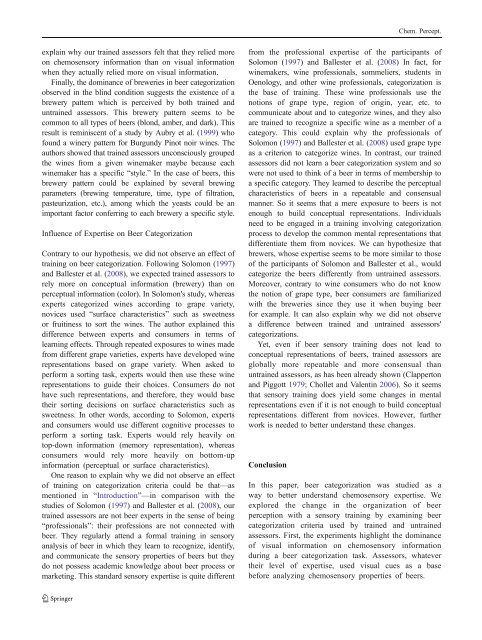le même processus pour tous - Université de Bourgogne
le même processus pour tous - Université de Bourgogne
le même processus pour tous - Université de Bourgogne
Create successful ePaper yourself
Turn your PDF publications into a flip-book with our unique Google optimized e-Paper software.
explain why our trained assessors felt that they relied more<br />
on chemosensory information than on visual information<br />
when they actually relied more on visual information.<br />
Finally, the dominance of breweries in beer categorization<br />
observed in the blind condition suggests the existence of a<br />
brewery pattern which is perceived by both trained and<br />
untrained assessors. This brewery pattern seems to be<br />
common to all types of beers (blond, amber, and dark). This<br />
result is reminiscent of a study by Aubry et al. (1999) who<br />
found a winery pattern for Burgundy Pinot noir wines. The<br />
authors showed that trained assessors unconsciously grouped<br />
the wines from a given winemaker maybe because each<br />
winemaker has a specific “sty<strong>le</strong>.” In the case of beers, this<br />
brewery pattern could be explained by several brewing<br />
parameters (brewing temperature, time, type of filtration,<br />
pasteurization, etc.), among which the yeasts could be an<br />
important factor conferring to each brewery a specific sty<strong>le</strong>.<br />
Influence of Expertise on Beer Categorization<br />
Contrary to our hypothesis, we did not observe an effect of<br />
training on beer categorization. Following Solomon (1997)<br />
and Bal<strong>le</strong>ster et al. (2008), we expected trained assessors to<br />
rely more on conceptual information (brewery) than on<br />
perceptual information (color). In Solomon's study, whereas<br />
experts categorized wines according to grape variety,<br />
novices used “surface characteristics” such as sweetness<br />
or fruitiness to sort the wines. The author explained this<br />
difference between experts and consumers in terms of<br />
<strong>le</strong>arning effects. Through repeated exposures to wines ma<strong>de</strong><br />
from different grape varieties, experts have <strong>de</strong>veloped wine<br />
representations based on grape variety. When asked to<br />
perform a sorting task, experts would then use these wine<br />
representations to gui<strong>de</strong> their choices. Consumers do not<br />
have such representations, and therefore, they would base<br />
their sorting <strong>de</strong>cisions on surface characteristics such as<br />
sweetness. In other words, according to Solomon, experts<br />
and consumers would use different cognitive processes to<br />
perform a sorting task. Experts would rely heavily on<br />
top-down information (memory representation), whereas<br />
consumers would rely more heavily on bottom-up<br />
information (perceptual or surface characteristics).<br />
One reason to explain why we did not observe an effect<br />
of training on categorization criteria could be that—as<br />
mentioned in “Introduction”—in comparison with the<br />
studies of Solomon (1997) and Bal<strong>le</strong>ster et al. (2008), our<br />
trained assessors are not beer experts in the sense of being<br />
“professionals”: their professions are not connected with<br />
beer. They regularly attend a formal training in sensory<br />
analysis of beer in which they <strong>le</strong>arn to recognize, i<strong>de</strong>ntify,<br />
and communicate the sensory properties of beers but they<br />
do not possess aca<strong>de</strong>mic know<strong>le</strong>dge about beer process or<br />
marketing. This standard sensory expertise is quite different<br />
from the professional expertise of the participants of<br />
Solomon (1997) and Bal<strong>le</strong>ster et al. (2008) In fact, for<br />
winemakers, wine professionals, sommeliers, stu<strong>de</strong>nts in<br />
Oenology, and other wine professionals, categorization is<br />
the base of training. These wine professionals use the<br />
notions of grape type, region of origin, year, etc. to<br />
communicate about and to categorize wines, and they also<br />
are trained to recognize a specific wine as a member of a<br />
category. This could explain why the professionals of<br />
Solomon (1997) and Bal<strong>le</strong>ster et al. (2008) used grape type<br />
as a criterion to categorize wines. In contrast, our trained<br />
assessors did not <strong>le</strong>arn a beer categorization system and so<br />
were not used to think of a beer in terms of membership to<br />
a specific category. They <strong>le</strong>arned to <strong>de</strong>scribe the perceptual<br />
characteristics of beers in a repeatab<strong>le</strong> and consensual<br />
manner. So it seems that a mere exposure to beers is not<br />
enough to build conceptual representations. Individuals<br />
need to be engaged in a training involving categorization<br />
process to <strong>de</strong>velop the common mental representations that<br />
differentiate them from novices. We can hypothesize that<br />
brewers, whose expertise seems to be more similar to those<br />
of the participants of Solomon and Bal<strong>le</strong>ster et al., would<br />
categorize the beers differently from untrained assessors.<br />
Moreover, contrary to wine consumers who do not know<br />
the notion of grape type, beer consumers are familiarized<br />
with the breweries since they use it when buying beer<br />
for examp<strong>le</strong>. It can also explain why we did not observe<br />
a difference between trained and untrained assessors'<br />
categorizations.<br />
Yet, even if beer sensory training does not <strong>le</strong>ad to<br />
conceptual representations of beers, trained assessors are<br />
globally more repeatab<strong>le</strong> and more consensual than<br />
untrained assessors, as has been already shown (Clapperton<br />
and Piggott 1979; Chol<strong>le</strong>t and Va<strong>le</strong>ntin 2006). So it seems<br />
that sensory training does yield some changes in mental<br />
representations even if it is not enough to build conceptual<br />
representations different from novices. However, further<br />
work is nee<strong>de</strong>d to better un<strong>de</strong>rstand these changes.<br />
Conclusion<br />
Chem. Percept.<br />
In this paper, beer categorization was studied as a<br />
way to better un<strong>de</strong>rstand chemosensory expertise. We<br />
explored the change in the organization of beer<br />
perception with a sensory training by examining beer<br />
categorization criteria used by trained and untrained<br />
assessors. First, the experiments highlight the dominance<br />
of visual information on chemosensory information<br />
during a beer categorization task. Assessors, whatever<br />
their <strong>le</strong>vel of expertise, used visual cues as a base<br />
before analyzing chemosensory properties of beers.

















